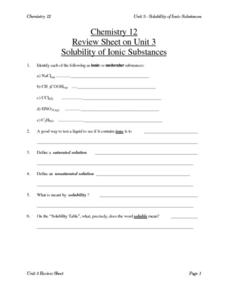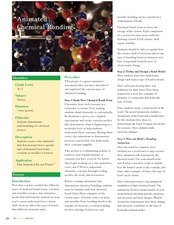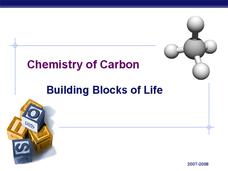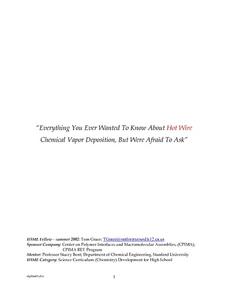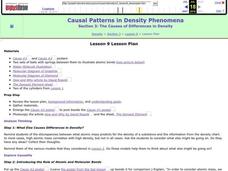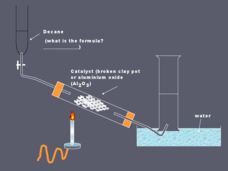Curated OER
Lewis Structures, VSEPR, Polarity, IM Forces
In this compounds worksheet, students draw the Lewis structures, indicating the molecular polarity and the major intermolecular force in each compound. This worksheet has 10 problems to solve.
Curated OER
Alkanes and Alkenes
In this alkanes worksheet, students use a data table to plot a graph of boiling point against number of carbon atoms. Students define cracking and double bond. This worksheet has 5 short answer questions.
Curated OER
Chemistry 1A Review
In this Chemistry 1A worksheet, students review, molecular weight, solubility, endothermic reactions, and number of protons, neutrons, and electrons for elements. Students review Lewis Structures and how to predict the amount of product...
Curated OER
Solubility of Ionic Substances
In this solubility worksheet, students identify substances as either ionic or molecular, define saturated solution and solubility, and calculate concentration of solutions. This worksheet has 7 short answer, 5 fill in the blank, and 27...
Curated OER
Lewis Structure Worksheet
In this chemistry worksheet, students draw the Lewis structures of 9 compounds and polyatomic ions, identify their molecular shapes and polarity.
Curated OER
Binary Compounds
Binary compounds are explained with the periodic table, atomic charges, and examples. Viewers are taught to name binary compounds and then are presented with a chart of cations and ions. Finally, they see a few photos of forms of silicon...
Curated OER
Organic Chemistry Practice Test
Framed as an organic chemistry practice test, this resource could be used for a variety of purposes. Composed of 15 questions about organic compounds such as isomers, alkynes, alkenes and amines, and other topics related to organic...
Curated OER
Lattice Energy
A few basic facts about lattice energy are listed at the top of the page, including the formula used for calculations. Two charts follow: one for lattice energy and another for ion sizes. There is no work to do on this handout, but it...
Curated OER
Animated Chemical Bonding
Students demonstrate their understanding of a chemical process. In this exploratory lesson students create a clay animation that shows how a specific type of chemical bond.
Cornell University
Radical Reactions
The radical reactions of polymers seems abstract to many pupils, but this lesson turns them into a fun building game. Scholars use dice and building pieces to build polymers. Then, they determine the theoretical and experimental weight...
Curated OER
More Fun with Lewis Structures
In this compounds worksheet, high schoolers draw the Lewis structures for the given compounds, being sure to show the bond angles and molecular shapes. This worksheet has 6 problems to solve.
Curated OER
Empirical Formulas
In this empirical formulas worksheet, students read about determining empirical formulas from chemical formulas. They determine the empirical formula given ten molecular formulas. They also find the molecular formulas given the mass and...
Curated OER
Investigating the Shapes of Covalent Molecules and Measuring their Respective Bond Lengths and Bond Angles
High schoolers will draw Lewis structures of common covalent compounds using a Chem 3D computer program. They will predict the shapes of the molecules, complete a data table, and formulate rules for predicting shapes of molecules. In the...
Curated OER
Molecular Structures or Visualizing Molecules
Learners identify and describe the molecular structure using the terms of Valance Shell Electron Pair Repulsion. Students predict simply molecular structure in various forms, as well as predict bond structure between atoms of a molecule....
Curated OER
Chemistry of Carbon - Building Blocks of Life
A great review of the structure and function of carbon-based molecules important to life, especially with relevance to humans. The chemistry behind the combination of polymers and the breakdown of bonds is covered. Valuable content in...
American Chemical Society
Controlling the Amount of Products in a Chemical Reaction
Everyone enjoys combining baking soda and water. Here is a lesson that challenges scholars to analyze the reaction three different ways — the real substances, the chemical equation, and the molecular models. Class members experiment to...
American Chemical Society
Why Does Water Dissolve Sugar?
Did you know that if you wait long enough, the M on the outside of an M and M will float to the surface when submerged in water? Learners observe the sugar coating of an M and M while it is dissolving in water. They explain how this...
Curated OER
Functional Groups ~ What is the Family Name?
These 37 slides start with definitions of six types of functional groups, their molecular structure, and multiple examples or each. During the rest of the presentation, organic chemistry learners are given an opportunity to practice...
Curated OER
Everything You Ever Wanted To Know About Hot Wire Chemical Vapor Deposition, But Were Afraid To Ask
To wrap up your year of general chemistry, have lab groups compete in a tot wire chemical vapor deposition (HWCVD) competition. With their foundation in chemical nomenclature, stoichiometry, and gas laws, each group completes several...
Curated OER
Intermolecular Forces Worksheet
In this intermolecular forces worksheet, learners answer 4 questions about the forces between atoms within molecules and compounds. Students rank the boiling points of compounds based on their intermolecular forces and they explain...
Curated OER
The Causes of Differences in Density
Young scholars explore what causes differences in density. They observe an models depecting atoms, compounds, and molecules. Students determine if there is air in between atomic bonds. They study the structure and spacing of molecular...
Curated OER
Addition Reactions
Here is a PowerPoint that displays multiple organic compound structures and asks viewers to identify the formulas, isomers, or potential products after a given addition reaction. This is a comprehensive set of slides that reviews...
Cornell University
The Making of Macromolecules
Compare and contrast macromolecules made from the same elements. Young scholars learn how the structure of a molecule has as much influence on a compound as the elements in the molecule. They experiment with molecular model kits to...
Curated OER
The Nature of Salt
High schoolers record information from the periodic table for sodium and chloride. They determine whether salts are molecular or ionic compounds, along with sodium chloride's molecular weight, and relative weights





